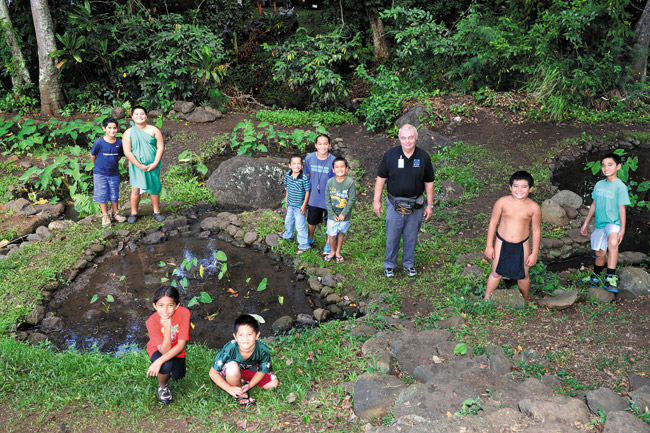Anuenue School’s Pono Po‘okumu

Ke Kula Kaiapuni ‘O Anuenue principal Charles Naumu with students at the school’s lo‘i | Photo by Nathalie Walker
Political and linguistic repression after the overthrow of the Hawaiian monarchy nearly brought an end to the language of its people, but deep in the lush vegetation of Palolo Valley, you hear old Hawaii flowing through the voices of Ke Kula Kaiapuni ‘O Anuenue students. They are pupils of Anuenue School, one of a dozen Hawaiian Language Immersion Programs (HLIP) operating in our state aimed at perpetuating the Hawaiian language and culture.
Along the border of Pukele Stream are taro patches planted last spring by immersion enrollees. Kindergarteners to high schoolers learn firsthand about Hawaiian native agriculture, and speaking their native tongue – one of two official state languages. Come April, they will harvest their crops. The younger kids will learn the craft of lau lau cuisine, and high schoolers will pound taro with precision to prepare poi for their end-of-the-school-year harmony class celebration. All subjects – math, science, social studies, etc. – are taught in Hawaiian, with the exception of English class. Its Rainbows football team huddles and sports instructions are spoken in the indigenous language.
Graduates have gone on to top-notch universities. Keliipio Adams, from the graduating class of 2008, petitioned for the school’s own football team his freshman year.
“We felt like pioneers who were perpetuating Hawaiian language as well as Hawaiian culture in an American sport. It was amazing,” he says. Adams went on to play at Mt. San Antonio College in Southern California, where his team garnered the Junior College National Championship in 2009. He later graduated as a scholar athlete from Nicholls State University in Thibodaux, La.
It was his principal, Charles Naumu, who inspired Adams.
“I believe that Po’okumu (principal) Naumu has made a tremendous impact for the Hawaiian people. He is at the frontline of our crusade, is supportive of seeing native Hawaiians strive in today’s society and is a true role model of the term pono.”
Today, Adams works as a teacher alongside mentor Naumu at his alma mater.
Former principal Lani Kapololu pioneered the transformation of Anuenue into a Hawaiian immersion school in 1996. In 1999, Naumu took over as captain of the program and launched the first graduating class.
“The dual analogy of Anuenue School can be equated with the double-hulled Hawaiian voyaging canoe Hokule’a. One hull is representative of the Hawaiian language and education. The second hull represents the English language and education. The students are expected to learn both in this globalized world,” explains Naumu, a Kaneohe resident, who has served as principal and vice principal from Waimanalo to Maili over the past four decades. Anuenue’s student body makeup is 40 percent male and 60 percent female. Ninety percent of the students are predominantly native Hawaiian, but it is not a requirement to be of Hawaiian ancestry to enroll.
Former immersion instructor and parent Kahea Farias, originally from Niihau, enrolled her son because she wanted him to speak her native tongue.
“Keokapukoa, who is 7 years old, has progressed in his ability to speak Hawaiian and now proudly communicates with family members on Niihau. We are pleased with the teachers and administration. Principal Naumu is at all school functions and he is at the flagpole every morning to greet parents and students,” says Farias.
Anuenue recently was awarded a full six-year accreditation by the Accrediting Commission for Schools.
“We are known as ‘The Aloha School’ because love abounds here,” says staff member Kaweihi Napolean.
Anuenue’s keys to success stem from native Hawaiian values that encourage the students to: 1) attend school, 2) listen to teachers, 3) do lessons and 4) speak Hawaiian.
A tremendous sense of pride has emerged. Enrollment has doubled to 400 since its inception and a preschool has been added – all done without seeking publicity and fanfare, and purely through the “coconut wireless,” thanks to a principal, Charles Naumu, who believes passionately that the preservation of an indigenous people and their native language and culture be perpetuated for generations to come.





